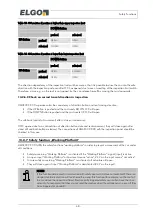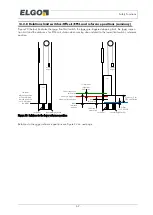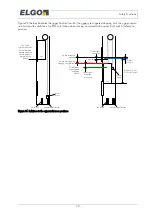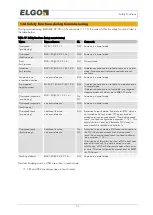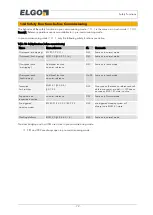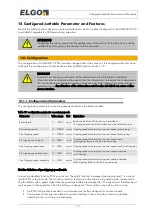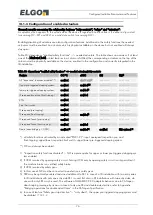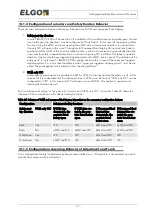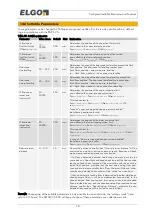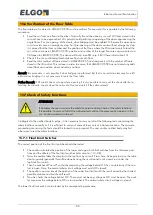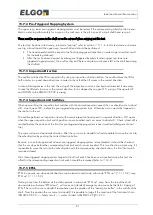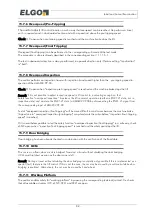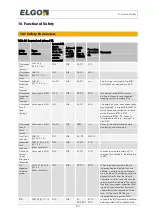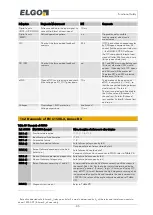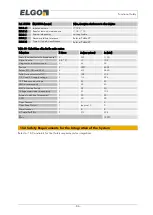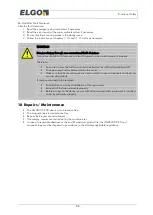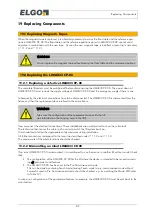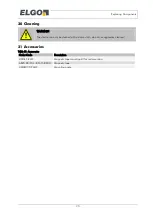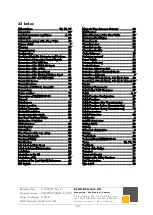
Initial and Annual Examination
- 81 -
15.7.2
Pre-Triggered Stopping System
The upper resp. lower pre-triggered stopping system must be tested, if the corresponding safety function is ena-
bled in order to perform safety for a man on the roof resp. in the pit in case of a short shaft head resp. pit.
There must be no person in the shaft or on the car roof when carrying out this test.
The test can be done in test mode, sub mode “pre-trig”, refer to section
11.1.6. In this test mode, sub mode
pre-trig a travel toward the upper resp. lower shaft end should be performed.
The travel speed should be equal to the final tripping speed inspection (in order to get a realistic result
for the braking distance).
After the car has been stopped by safety gear (triggered by safety function upper rep. lower pre-
triggered stopping system), the auditor checks if there is ample survival space left in the shaft bead resp.
the shaft pit.
15.7.3
Inspection Direction
The auditor switches the lift to inspection. By using an inspection direction button, the auditor drives the lift for
half a meter in up and down directions in order to check that the lift moves in the correct direction.
In case of discrepancies in this test, the wiring of the inspection control is checked and corrected if necessary.
In case the lift starts to move in the correct direction, but is stopped by an open OC, wiring of the signals UP
and DOWN to the LIMAX33 CP-00 is wrong.
15.7.4
Inspection Limit Switches
When approaching the inspection limit switches with the normal inspection speed, the car should come to stand
still – due to open OC - before the pre-triggered stopping system trips. Otherwise a man would be trapped on
the roof or in the pit.
The auditor performs an inspection travel with normal inspection travel speed in upwards direction. OC opens
when the upper inspection limit switch position is over-travelled and car comes to stand still. Check: stand still is
reached before the position of the limit for pre-triggered stopping system is over travelled (safety gear did not
trip)
The same is done in downwards direction. After the car came to standstill it should possible to move the car into
the safe direction by pushing the correct direction button.
Remark: in case that upper and/or lower pre-triggered stopping system is/are disabled, it should be checked,
that the car stops before the corresponding final limit switch is over travelled. This is verified in a simple way: if it
is possible to move the car into the safe direction with the corresponding direction button, the final limit switch
remained closed.
Hint: If pre-triggered stopping system tripped or final limit switch has been over travelled during this test, the
offset for the corresponding inspection limit switch should be increased (refer to
15.7.5
ETSL
ETSL in upwards rep. downwards direction can be tested in test mode, sub mode “ETSL up” (
11.1.5.2), resp.
ETSL up” (
Starting a trip from the bottom of the shaft upwards in sub mode “ETSL up”, resp. from the top of the shaft
downwards in sub mode “ETSL down”, will cause an (intended) emergency stop cause by the (test-) tripping of
ETSL. The car will come to standstill somewhere near the position of the “assumptive buffer” in the middle of the
shaft. From the position the car came to standstill, it is possible to judge if the reaction of the functional chain
(LIMAX33 CP-00 => Safety circuit => motor / brake) fulfils EN81-20 §5.12.1.3.
Summary of Contents for LIMAX33 CP-00 SERIES
Page 91: ...91 Notes...


